
| Genus List | Species List |
The genus Hypoponera usually triggers avoidance behavior in myrmecologists. Phil Ward has described them as "remarkably featureless." It has been said that Bill Brown "broke his pick" attempting to understand the genus at a global level. The genus is monotonously uniform in habitus, and it is a boring habitus. If Ponerinae is a Mr. Potato Head game, Hypoponera is the potato. So why bother? Because Hypoponera are relatively common ants, and they are an important element in biodiversity surveys involving ants. When multiple collections from the same area are examined, they can be separated into distinct morphological clusters (the usual evidence for sympatric species), and the clusters have distinct habitat preferences. In mature forest areas they segregate by vertical microhabitat,some preferring the forest floor, others living in the soil that accumulates beneath epiphyte mats high in the canopy. Others prefer open or highly disturbed habitats. These are often "tramp" species spread widely by human commerce.
Caveat
The identification tools provided here will certainly prove frustrating to a novice attempting to identify a single specimen. This is a first attempt at drawing species boundaries for a set of 90 collections, and does not represent very extensive research on the group. A great deal more could be done with morphometrics and the analysis of additional collections. Also, I rely almost entirely on morphospecies code-names. A few named species have type localities within Costa Rica, and I am in the process of borrowing types for these, but ultimately a stable nomenclature will not be possible until species boundaries beyond Costa Rica are understood.
Intercastes
Hypoponera is renowned for caste flexibility. Intercastes between workers and queens are common, showing all degrees of intergradation. Intercastes often look like regular workers, but have larger compound eyes and traces of ocelli. Some species also may have ergatoid (worker-like) males, which can be distinguished by the presence of genitalia, and sometimes 13 antennal segments. The identification guide assumes regular workers; intercastes may not key well or may lead to the wrong species. Also, I have made no attempt at this point to identify queens and males.
Characters used in Identification

Head length (HL): maximum length of head in full-face view, along median axis, from anteromedian border of clypeus to posteriormost point of vertex (or to line tangent to posteriormost points of vertex if head medially concave behind).
Head width (HW): maximum head width, including eyes if they project from sides of head, perpendicular to HL.
Scape length (SL): scape length, not including basal constriction and condyle.
Oculomandibular distance (OMD): When the head is viewed from the side, the anterior border of the head capsule forms a relatively straight line more or less perpendicular to the long axis of the head. OMD is the perpendicular distance from this line to the lower margin of the eye. The lateral wing of the clypeus forms a wedge between this border and the mandible. To see the juncture between the head capsule border and the clypeus requires practice and the right lighting, and can be difficult, especially on very small workers. However, it is important to measure from this border and not from the anterolateral border of the clypeus.
For the identification tools provided here, I developed a dataset of measurements for about 90 specimens. Bivariate scatterplots proved useful for differentiating species, and I have reproduced many of those plots here. Identification can be facilitated by comparing measurements of new material with these plots. The allometry is often such that indices commonly used by myrmecologists (e.g. scape index) are not as revealing as the plot itself.
Key to Hypoponera Species Known from Costa Rica, Based on Workers
10a. Scape extends well beyond margin of vertex (SL/HL greater than 0.86); HL 0.82-0.97mm; eye with more than 10 facets; shiny, black-brown with blue irridescence: nitidula
10b. Scape just attaining or falling short of margin of vertex (SL/HL less than 0.86); other characters various: 100

100a. OMD usually greater than 0.10mm; OMD/HL greater than 0.15 unless HL greater than 0.9mm: 150
100b. OMD usually less than 0.10mm; OMD/HL less than 0.15: 400
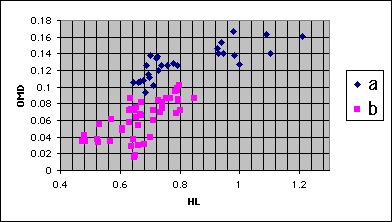
(Higher resolution version of this graph)
150a. Color light red brown; petiole in lateral view relatively thicker and with dorsum somewhat flat-topped; dorsal face of propodeum somewhat depressed below level of promesonotum: JTL-016
150b. Color usually darker brown; petiole thinner and with dorsum more rounded; promesonotum and dorsal face of propodeum forming a more continuous convexity: 200

200a. HL greater than 0.85mm: 250
200b. HL less than 0.85mm: 300

250a. HL less than 1.00mm: distinguenda
250b. HL greater than 1.05mm: JTL-006

300a. Petiolar node relatively thinner; scape relatively longer; color uniformly dark brown to lighter red brown: JTL-007
300b. Petiolar node relatively thicker; scape relatively shorter; color red brown, often with gaster or head and gaster darker: JTL-010


400a. Head relatively wider; color usually uniformly dark red brown to black; HL greater than 0.60mm: 500
400b. Head relatively narrower; color uniformly light red brown to orange, or mesosoma light red brown and head darker brown, or, if darker brown, HL less than 0.60mm: 600
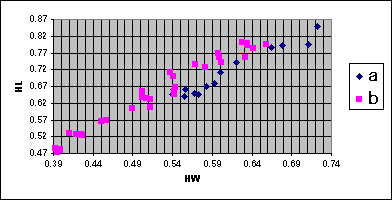
(Higher resolution version of this graph)
500a. Petiolar node distinctly cuboidal, with flat top: opaciceps
500b. Petiolar node less cuboidal, more tapered and scale-shaped: 520
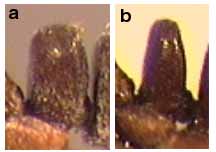
520a. SL/HL greater than 80; HL greater than 0.73mm; eyes composed of 10 or more distinct facets: JTL-002
520b. SL/HL less than 80; HL less than 0.73mm; eyes rarely with up to 10 facets, but usually smaller, appearing to be a single facet or several partially fused facets: 560

560a. Color red brown; petiole thin, high, scale-like; dorsal face of propodeum sloping, curving gradually into posterior face: creola
560b. Color darker; petiole relatively thicker; dorsal face of propodeum less sloping, more differentiated from posterior face: opacior

600a. Mesosoma and gaster orange brown, head contrastingly darker brown; HL greater than 0.70mm; eye highly variable in size, composed of 7 to 15 or more partially fused facets; scapes relatively short, failing to attain margin of vertex: JTL-003
600b. Not exactly fitting above description; color usually concolorous orange or light orange brown; eyes generally composed of fewer than 7 partially fused facets or appearing as a single facet; if HL greater than 0.70mm, scapes usually relatively longer: 640

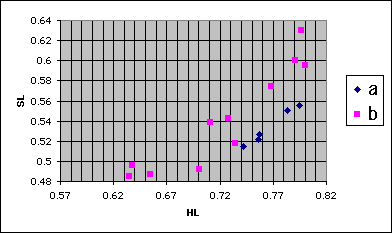
640a. Petiolar node relatively shorter and broader, less scale-like: punctatissima
640b. Petiolar node relatively thinner, scale-like: 680

680a. Scapes relatively shorter; propodeum not strongly tectiform (tent-like), sides broadly rounding into dorsal face: JTL-013
680b. Scapes relatively longer; propodeum variable: 700

700a. HL greater than 0.60mm; propodeum tectiform, with sides strongly sloping to narrow dorsal face: JTL-001
700b. HL less than 0.60mm; propodeum less strongly tectiform, with broader dorsal face: parva
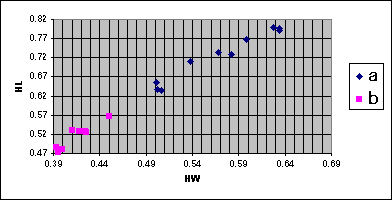
Page author:
John T. Longino, The Evergreen State College, Olympia WA 98505 USA.longinoj@evergreen.edu